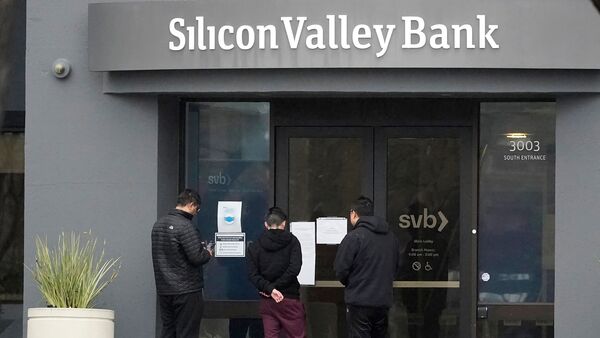The dust is only just beginning to settle on two of the largest bank failures in US banking history. The failures happened within a noticeably short time of each other. Across the Atlantic, regulators forced the merger of a 166-year-old institution with its arch-rival, a similarly pedigreed bank. Market participants everywhere are nervous that even the faintest gust may get the dust swirling again.
The failure of Silicon Valley Bank (SVB), Signature Bank and Silvergate Bank woke up global markets to the gradually building stress on bank balance sheets from a continual rise in interest rates from pandemic lows. The anatomy of this crisis shows many classical features, though with an important new addition.
Counter-intuitive to most lay observers, deposits made by individuals and institutions in banks are called ‘liabilities’, meaning they must be returned to the depositor at some future point. Loans and advances made by the bank are called ‘assets’, because they must eventually be returned to the bank with interest. What causes a bank run, a panicky withdrawal of deposits, is a real or perceived reduction in the value of loans.
The value of loans on a bank’s books can reduce for three reasons. 1) Quality: Banks lend to companies and individuals across the credit spectrum. If one segment of credit were to turn bad, then the bank’s portfolio would need to be marked down to reflect it. This is what happened when Washington Mutual Bank, with its sub-prime mortgage portfolio, failed in 2008 (the largest failure in US banking history). 2) Sector: Banks can be concentrated in sectors that they lend to. When those sectors are under pressure, the banks feel the stress as well. This is what happened when the National Republic Bank of Chicago failed in 2014 because almost all its loans were to Indian-diaspora owners of motels and gas stations. More recently, Silvergate Bank, with its concentration in crypto markets, folded because of the same problem. And 3) maturity: This is the oldest type of risk known for a loan portfolio. If interest rates rise fast and far, the value of the bond portfolio drops. This is the primary reason for the failure of SVB.
In SVB’s case, the technology sector’s current problems and losses that would arise from marking its sovereign bond portfolio to market values resulted in failure. There is also another technical reason for SVB’s collapse. SVB held its treasury bond portfolio in the ‘held to maturity’ (HTM) category, and virtually none of it in the “available for sale (AFS) category.
Holding bonds in the HTM category implies SVB carried its bond portfolio at book value without having to ‘mark-to-market’. This gave a false sense of the value of its portfolio even as rates were rising. SVB’s bond portfolio was nearly $120 billion, or 57% of its asset portfolio. By some estimates, this needed to be marked down about 20% or $24 billion. Its shareholder equity was $16 billion. A bank is technically insolvent when a loss from ‘marking to market’ is greater than its equity base.
From the outside in, one school of analysts places the blame squarely on the US Federal Reserve for first yanking rates down to zero and then hiking them at a fast and furious pace back (now to 5%); a second places the blame entirely on the bank for its incompetent risk management and its concentrated holding in long treasuries in the HTM bucket; a third school believes that regulation for small and regional banks and supervision over their risk management had become quite lax. This school holds that the annual stress review with strict assumptions that large banks must undergo would have shown them up for their cavalier attitude to risk. A fourth group believes that the ‘modern twist’ to this old tale comes entirely from social media. This was a bank run engineered entirely by a Twitter storm, involving largely the very people that SVB called its community. The speed with which the run occurred and the collapse happened gives credence to this theory.
My view is that incompetent risk management was the main reason, compounded by all the other factors. SVB management was alerted to those risks several times in the second half of 2022, but chose not to act. SVB was indeed a great bank for solutions for its technology clients, but turned out to be a poor manager of its own balance sheet. That offers a cautionary lesson to a whole host of technology companies that seek to become banks.
Indian regulators and markets have been watching these developments with caution. The Reserve Bank of India (RBI) has strict regulations on how much of a bank’s portfolio can be held in the HTM category. While that limit has crept up to 23%, it will fall back in a phased manner to 19.5%. This simple fix might have obviated SVB’s problem entirely. In addition, RBI’s annual financial inspection of banks, big or small, ensures that lenders are cognizant of risks that arise from asset/liability mismatches. Indian banks are subject to sector and credit concentration risks in general, and from evergreening of loans, but it appears unlikely that maturity risk will manifest in the same way.
On the other hand, financial solutions offered by Indian banks for client challenges remain dull and archaic. Do improved solutions in our banking sector necessarily have to mean greater risks borne? A yet to be born Koramangala Valley Digital Bank might offer the answer.
P.S: “We made too many wrong mistakes,” said the enigmatic Yogi Berra.
Narayan Ramachandran is chairman, InKlude Labs. Read Narayan’s Mint columns at www.livemint.com/avisiblehand
Download The Mint News App to get Daily Market Updates.
More
Less
#regular #bank #failures #modern #twists
